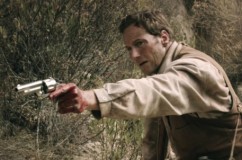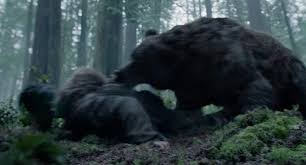 Patrick Wilson as Arthur, hoping to save the day and his beloved
Patrick Wilson as Arthur, hoping to save the day and his beloved Bone Tomahawk has been widely labeled a “horror/western,” and I understand the impulse to do so; like its brethren Ravenous and Cowboys and Aliens, it does cross genre boundaries a bit, although in the end, I think the horrific aspect of a cannibalistic tribe tucked away in the mountains stays much closer to the traditional genre boundaries than either of the earlier films do.
To address the complaints of some of my friends, who said there was one scene in particular that lost them; yes, I know which scene you mean, and I too found it gratuitous and, more importantly, pointless. Once Deputy Nick is taken from his cell, viewers know exactly what will become of him, and seeing the violent end to this character on center stage does little to forward the plot or even heighten tension. I feel it would actually have been more effective to have the tortuous action occur offscreen, allowing viewers’ imaginations to fill in the blanks. However, it is also a brief scene, and I think the rest of the film is effective enough to give it a pass.
Back to its assets. One thing I think the film does really well is that by setting the antagonists as a mysterious “tribe” who are shunned and feared even by the local native tribes, the film is able to cast an “Other” as the enemy without complicating our contemporary attitudes toward westward expansion and the subjugation of native tribes. There is a small but effective scene in which a native character (played by Longmire’s Zahn McClarnon) advises the posse not to go, saying that his tribe avoids this canyon because they’re so dangerous. This effectively establishes that the tribe is not Indian, and heightens their otherworldy aspect.
Had this film been made in the 50s or 60s, it would have been easy enough to make the bad guys “Indians” and be done with it, and no one would have questioned the choice. But westerns have evolved with our national consciousness, and we no longer uncritically accept Native Americans as the natural antagonist, even in a western. So Bone Tomahawk is able to deftly recast the Other as an unnatural tribe of flesh eaters, maintaining the dichotomy of hero and villain without creating the cognitive dissonance of imperialism or conquest that older westerns may have to a younger generation.
Finally, this film (unlike the Hateful Eight), reifies an old genre staple and provides something close to a happy ending – well, happy for at least a couple of characters, anyway. I won’t spoil it further, but the film concludes on a fairly positive note, giving viewers a satisfying resolution. The film is gritty and even brutal, to be sure, but in the end it reifies the social construct that was disrupted by the antagonists, and finally privileges the values of heroism, loyalty, and ultimately the power of love.

 RSS Feed
RSS Feed
